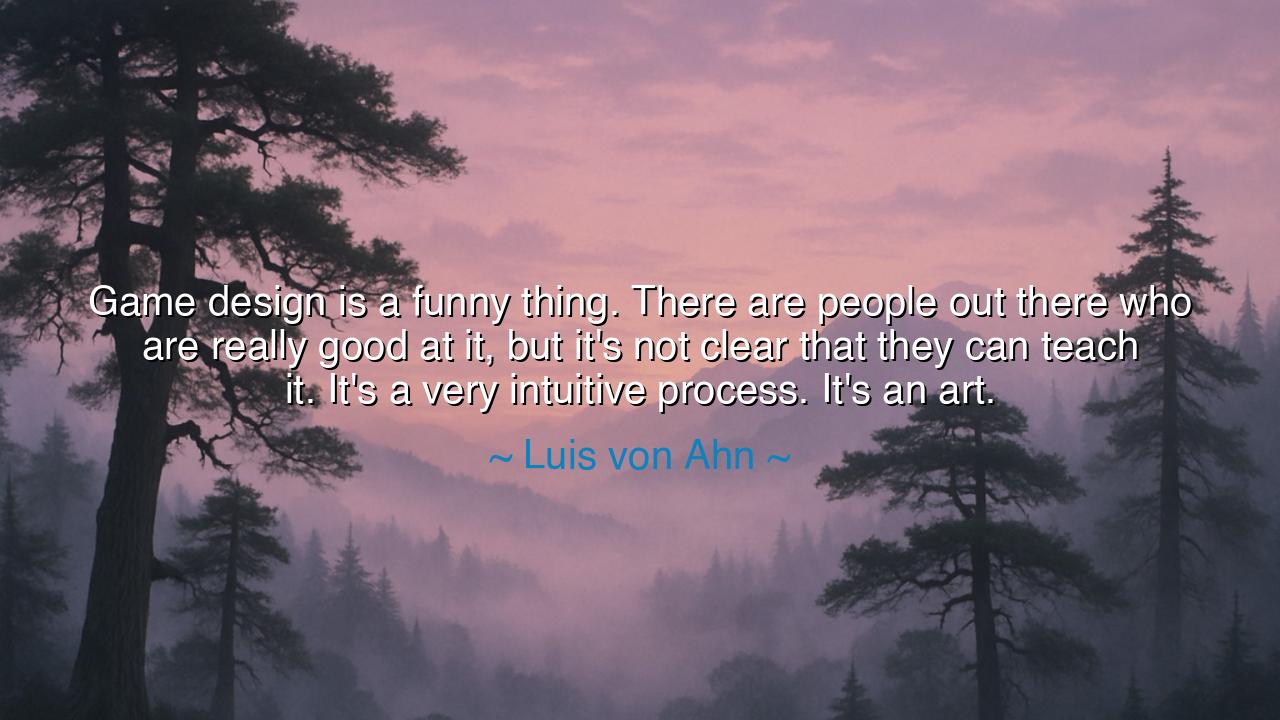
Game design is a funny thing. There are people out there who are
Game design is a funny thing. There are people out there who are really good at it, but it's not clear that they can teach it. It's a very intuitive process. It's an art.






“Game design is a funny thing. There are people out there who are really good at it, but it's not clear that they can teach it. It's a very intuitive process. It's an art.” So spoke Luis von Ahn, a mind known for blending intellect with play, a creator who built worlds of learning disguised as games. His words are not only about game design, but about the mysterious nature of creativity itself — that sacred fire which cannot always be caged by logic or taught through rules. In this saying lies a truth older than the written word: that art is born from the marriage of instinct and soul, not merely from structure or instruction.
From the dawn of civilization, the ancients knew that the crafts of creation — whether in music, in sculpture, or in storytelling — could be guided but never wholly taught. The artist, like the game designer, is a vessel through which the unseen takes form. The sculptor may study anatomy, but it is something beyond knowledge that breathes life into the marble. So too in the making of games: one may learn the mechanics, the systems, the logic of design — yet only those who feel the rhythm of human joy and curiosity can craft experiences that awaken wonder. This, von Ahn calls intuition — the wisdom of the heart, not the mind.
Consider the tale of Shigeru Miyamoto, the creator of worlds like The Legend of Zelda and Super Mario Bros.. He did not follow a formula, nor was he guided by textbooks or design patterns. Instead, he drew upon the childlike curiosity within him — memories of exploring caves and fields in rural Japan. He translated those feelings into gameplay, crafting journeys that resonated with millions. Could he have taught that feeling? Could he have written it in a manual? No. For his genius was not in the method, but in the intuition — the ability to see play as a reflection of life’s wonder. That is what von Ahn means when he calls game design an art.
Art, in its truest form, defies containment. It is not the echo of rules but the voice of experience. Those who try to teach art can guide others to the door, but they cannot open it for them. The door opens only when the soul begins to see. The great masters of any craft — from Da Vinci with his brush to Miyamoto with his controller — did not follow a map. They walked into the forest of imagination, guided by the faint torchlight of instinct. And there, they found paths where none had existed before. So too must all creators — especially those who shape worlds for others to play in — trust their intuition as much as their intellect.
Von Ahn’s insight reminds us that not all knowledge is of the mind. Some knowledge flows from feeling — from empathy, curiosity, and play. Game design, at its core, is about understanding the soul of the player: what makes them smile, what makes them strive, what makes them care. These are not things that can be measured with diagrams or metrics alone. They require the same listening that poets give to silence, or that composers give to the spaces between notes. To design a game — or any meaningful creation — is to shape emotion, and emotion is the oldest and deepest language of humankind.
Let us then pass down this truth: that creation cannot be caged by instruction. We may study the patterns of great designers, but we must also cultivate the inner flame that drives them. The student who copies the master’s brushstrokes may learn form, but only by painting with his own heart will he learn art. The apprentice of design must learn not only to build systems, but to listen — to people, to stories, to joy itself. For intuition, though unseen, is the compass that guides every true creator.
And so, to those who wish to craft — whether games, poems, or lives themselves — let this be your teaching: Learn the craft, but trust the art. Study the rules, then break them with wisdom. Listen to your mind, but follow your heart when it speaks softly beneath the noise. For art, in the end, is not a formula to be mastered, but a flame to be tended — and when it burns within you, it lights the way not just for yourself, but for all who will one day play in the worlds you’ve imagined.






AAdministratorAdministrator
Welcome, honored guests. Please leave a comment, we will respond soon